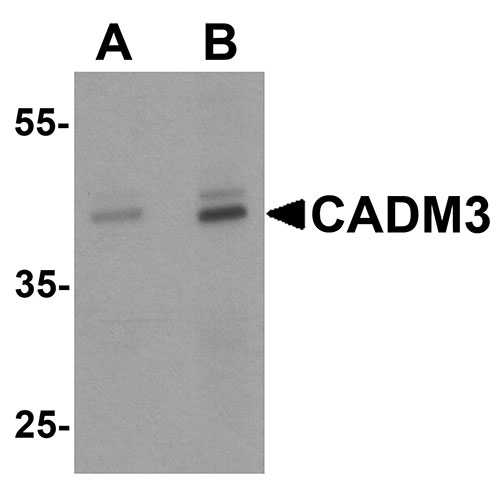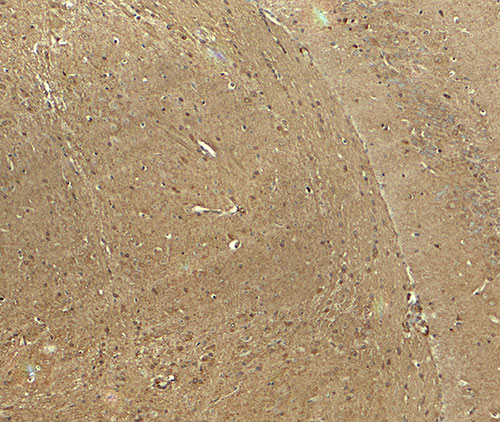CADM3 Antibody
- SPECIFICATION
- CITATIONS
- PROTOCOLS
- BACKGROUND

Application
| WB, IHC-P, IF, E |
|---|---|
| Primary Accession | Q8N126 |
| Other Accession | NP_067012, 11056046 |
| Reactivity | Human, Mouse, Rat |
| Host | Rabbit |
| Clonality | Polyclonal |
| Isotype | IgG |
| Calculated MW | Predicted: 44, 48 kDa Observed: 44 kDa |
| Application Notes | CADM3 antibody can be used for detection of CADM3 by Western blot at 1 - 2 µg/ml. Antibody can also be used for immunohistochemistry starting at 5 µg/mL. For immunofluorescence start at 20 µg/mL. |
| Gene ID | 57863 |
|---|---|
| Target/Specificity | CADM3; CADM3 antibody is human, mouse and rat reactive. At least three isoforms are known to exist; this antibody will only detect the two longest isoforms. CADM3 antibody is predicted to not cross-react with other members of the CADM protein family. |
| Reconstitution & Storage | CADM3 antibody can be stored at 4℃ for three months and -20℃, stable for up to one year. |
| Precautions | CADM3 Antibody is for research use only and not for use in diagnostic or therapeutic procedures. |
| Name | CADM3 |
|---|---|
| Synonyms | IGSF4B, NECL1, SYNCAM3, TSLL1 |
| Function | Involved in the cell-cell adhesion. Has both calcium- independent homophilic cell-cell adhesion activity and calcium- independent heterophilic cell-cell adhesion activity with IGSF4, NECTIN1 and NECTIN3. Interaction with EPB41L1 may regulate structure or function of cell-cell junctions (By similarity). |
| Cellular Location | Cell membrane {ECO:0000250|UniProtKB:Q99N28}; Single-pass type I membrane protein {ECO:0000250|UniProtKB:Q99N28} Cell junction {ECO:0000250|UniProtKB:Q99N28} |
| Tissue Location | Isoform 1 is expressed mainly in adult and fetal brain. Isoform 2 is highly expressed in adult brain and weakly expressed in placenta. In brain, Isoform 2 is highly expressed in cerebellum. |

Thousands of laboratories across the world have published research that depended on the performance of antibodies from Abcepta to advance their research. Check out links to articles that cite our products in major peer-reviewed journals, organized by research category.
info@abcepta.com, and receive a free "I Love Antibodies" mug.
Provided below are standard protocols that you may find useful for product applications.
Background
Cell adhesion molecule 3 (CADM3) is a member of a family of immunoglobulin-like, calcium-independent cell-cell adhesion molecules (1,2). CADM3 localizes to non-junctional contact sites of presynaptic nerve terminals, axons and glia cell processes and is thought to play an important role in the formation of synapses, axon bundles and myelinated axons (3). Recently, CADM3 has been shown to suppress the growth and tumorigenic ability of colon cancer cells, indicating that it can act as a tumor suppressor (4).
References
Fukuhara H, Kuramochi M, Nobukuni T, et al. Isolation of the TSLL1 and TSLL2 genes, members of the tumor suppressor TSLC1 gene family encoding transmembrane proteins. Oncogene 2001; 20:5401-7.
Takai Y, Mioshi J, Ikeda W, et al. Nectins and nectin-like molecules: roles in contact inhibition of cell movement and proliferation. Nat. Rev. Mol. Cell Biol. 2008; 9:603-15.
Kakunaga S, Ikeda W, Itoh S, et al. Nectin-like molecule-1/TSLL1/SynCAM3: a neural tissue-specific immunoglobulin-like cell-cell adhesion molecule localizing at non-junctional contact sites of presynaptic nerve terminals, axons and glia cell processes. J. Cell Sci. 2005; 118:1267-77.
Raveh S, Gavert N, Spiegel I, et al. The cell adhesion nectin-like (Necl) molecules 1 and 4 suppress the growth and tumorigenic ability of colon cancer cells. J. Biol. Biochem. 2009; 108:326-36.
If you have used an Abcepta product and would like to share how it has performed, please click on the "Submit Review" button and provide the requested information. Our staff will examine and post your review and contact you if needed.
If you have any additional inquiries please email technical services at tech@abcepta.com.













 Foundational characteristics of cancer include proliferation, angiogenesis, migration, evasion of apoptosis, and cellular immortality. Find key markers for these cellular processes and antibodies to detect them.
Foundational characteristics of cancer include proliferation, angiogenesis, migration, evasion of apoptosis, and cellular immortality. Find key markers for these cellular processes and antibodies to detect them. The SUMOplot™ Analysis Program predicts and scores sumoylation sites in your protein. SUMOylation is a post-translational modification involved in various cellular processes, such as nuclear-cytosolic transport, transcriptional regulation, apoptosis, protein stability, response to stress, and progression through the cell cycle.
The SUMOplot™ Analysis Program predicts and scores sumoylation sites in your protein. SUMOylation is a post-translational modification involved in various cellular processes, such as nuclear-cytosolic transport, transcriptional regulation, apoptosis, protein stability, response to stress, and progression through the cell cycle. The Autophagy Receptor Motif Plotter predicts and scores autophagy receptor binding sites in your protein. Identifying proteins connected to this pathway is critical to understanding the role of autophagy in physiological as well as pathological processes such as development, differentiation, neurodegenerative diseases, stress, infection, and cancer.
The Autophagy Receptor Motif Plotter predicts and scores autophagy receptor binding sites in your protein. Identifying proteins connected to this pathway is critical to understanding the role of autophagy in physiological as well as pathological processes such as development, differentiation, neurodegenerative diseases, stress, infection, and cancer.




